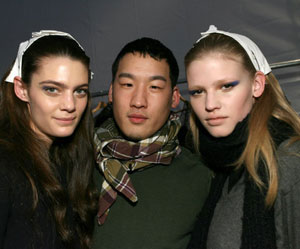An Wang, Amar Bose, Charles Wang, David Ho, Jerry Yang, Steven Chu and many tens of thousands of other scientists and technologists have made Asian Americans practically synonymous with tech leadership during the 1980s and 1990s. That was then. Now Asian Americans are emerging as leaders of America’s cultural evolution into the 21st century.
Fashion designers like Vera Wang, Richard Chai and Jason Wu are helping Americans lose fuddy-duddy notions of how to dress. Chefs like Roy Yamaguchi, Ming Tsai and David Chang have added hot new angles to what we eat. Authors like Chang-rae Lee, Ha Jin and Jhumpa Lahiri are serving up the freshest words in American letters. Filmmakers like Ang Lee, John Woo, M. Knight Shymalan and Justin Lin are opening palates to new film flavors. Even in the stodgy corporate sphere Asian American marketers like Jon Iwata (IBM), Esther Lee (AT&T) and Geri Wang (ABC) are rewriting rules on how businesses relate to customers in a sophisticated global marketplace.
Behind the big names are a swelling wave of creative types and free spirits who, in the coming decade, will help Asian Americans achieve the same prominence in the cultural and media spheres as we have long enjoyed in science and technology.
We all understand the cultural biases that drove us to become America’s tech leaders. All those Asian parents determined to push their kids to succeed in more technical and therefore presumably more colorblind professions (the Pushers) fueled a sustained influx of Asian American talent and discipline into the fields of science, engineering, medicine and business. Less obvious are the social forces now propelling so many young Asians to the forefront of fields that offer far less certain pathways to regular paychecks.
Call it the Pushback Generation. Those Asian Americans who had been forced to fit themselves into the sciences regardless of their own talents and dreams (call them the Pushed) have offspring who are now coming into their own. The Pushed were determined not to subject their kids to the same mindless pressures. To the contrary, I suspect many went out of their way to protect their kids from the intense peer pressure to conform to the Asian immigrant fixation on getting on the well-paved path to job security. So their offspring, the Pushbacks, enjoyed the advantages of being reared in affluent professional households without the same pressures to sublimate its interests. The result is maybe a tenfold increase in Asian American talent pursuing creative goals.
Asian American Pushbacks enjoy a big edge over peers who are otherwise equally well-educated and liberated from parental demands. Having grown up in households with as much immersion in Asian foods, fads and philosophies as in American ones, Pushbacks are at ease with the role of taste arbiters in a world taking more of its pop culture cues from Asia. Call it the Bi-cultural Edge.
That edge helps Asian Americans in the creative pursuits cut through the calcified tastes and habits that were slowly turning America into a backwater of overfed, overflounced and underspiced people. When that cultural fluency is overlayed with America’s longstanding cultural hegemony powered by wealth, military might and shameless hustling of rock music and easy sex in tacky but well-paced Hollywood movies, you have a world-beating combination that will inevitably make Asian Americans the arbiters of not only American culture but of global culture.

